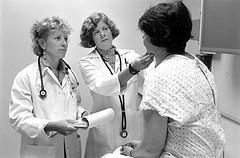
Image courtesy of Seattle Municipal Archives under a Creative Commons license: BY.
MedEd Portal Peer Reviewed
The overall objective of this case is to provide students with an opportunity to focus on the important aspects of the social history and how it relates to the current medical issues at hand. In this session we want to focus on their skills in obtaining adequate and useful information about the patient's social context in the medical interview. This module has been found to help first and second year medical students understand the role physicians have in caring for patients with limited English proficiency. This case is designed to be delivered in small group interactions with a faculty facilitator. It can be done in one setting or over 2 sessions.
Instructor: Monica L. Lypson
Structure: Case Study and Exercise
NLM Citation: Lypson M , Perlman R, Stalburg C, Johnston C, Lash R, Ross P, What Patients Bring to the Medical Encounter? Dealing with the Whole Patient. MedEdPORTAL; 2010. Available from:http://services.aamc.org/30/mededportal/servlet/s/segment/mededportal/?subid=8068
Instructions
The overall objective of this case is to provide students with an opportunity to focus on the important aspects of the social history and how it relates to the current medical issues at hand. In this session we want to focus on their skills in obtaining adequate and useful information about the patients’ social context in the medical interview. The case is written at the level of M1/M2 students. However could easily be adapted for higher level learners.
In the implementation of this case at our medical center we have asked students or the facilitator to at the least read the findings aloud. Some groups have opted to present the information as a role-play exercise. Thus far, we have not included a standardized patient, but that could be one adaptation of the case.
Session Overview & Format
This is a phased case that comes in 3 parts:
- Component 1: written assignment to hand in and review during the first part of class
- Component 2: small groups of 3-12 students (45 minutes)
- Component 3: small group s of 3-12 students (45 minutes)
Intended Learning Outcomes
Students should be able to:
- Describe health data within immigration context
- Discuss social determinants on health
- Identify how education, literacy and social economic status might impact health
- Assess Patients ability to read and understand information/instructions
- Assess how finances and/or insurance influence health care and adherence to recommendations
- Understand the importance of physician-patient negotiation
- Assess and enhance patient adherence with communication skills
- Develop communication, interaction, and interviewing skills
- Assess identified stressors in patients life
Written Assignment
The written assignment is used to promote self-directed learning and reflection in the area of social determinants of health. Additionally, the assignment is meant to promote student learning in the areas of prevention and screening. The assignment insures that students have read the assignment and come to the small group prepared. This assignment is not graded, but was reviewed prior to the session by the faculty facilitator.
Facilitators can decide whether or not they want to review these assignments in the small group setting and should plan their time accordingly.
Learning Objectives
Participants who complete this module will be able to:
- Describe health data with in immigration context.
- Discuss social determinants on health.
- Identify how education, literacy and social economic status might impact health.
- Assess patients ability to read and understand information/instructions.
- Assess how finances and/or insurance influence health care and adherence.
- Understand the importance of physician-patient negotiation.
- Assess and enhance patient adherence with communication skills.
- Develop communication, interaction, and interviewing skills.
- Assess identified stressors in patients life.
Reading List
Safeer RS. Keenan J. Health literacy: the gap between physicians and patients. Amer Fam Phys. 72(3):463-8, 2005 Aug 1.
Echeverria SE. Carrasquillo O. The roles of citizenship status, acculturation, and health insurance in breast and cervical cancer screening among immigrant women. Med Care. 44(8):788-92, 2006 Aug.
Behbakht K, et al. Social and cultural barriers to Papanicolaou test screening in an urban population. Obstet Gynecol December 2004;104:1355-61
Weiss, BD. Removing barriers to better, safer care, Health literacy and patient safety: Help patients understand: Manual for clinicians, Second edition. This Electronic Resource can be found on the American Medical Association’s website.
About the Creators

Dr. Lypson is the Assistant Dean for Graduate Medical Education at the University of Michigan School of Medicine. Throughout her career, Dr. Lypson has focused on medical education. She has worked with the National Board of Medical Examiners and the Accreditation Council on Graduate Medical Education and has served on numerous committees that have allowed her to explore medical education at local, regional and national levels. She uses this expertise to monitor the accreditation status and educational quality of our residency programs.
Dr. Lypson's research interests include resident assessment, historical and contemporary trends in medical education, academic leadership and the under representation of minorities in academic medicine. Several of her invited presentations and papers have focused on clinical performance assessment of medical students and residents and on recruiting minority faculty.
Dr. Lypson also plays a role in our medical school curriculum as the faculty director of the Multicultural curriculum and core faculty for the Family Centered Experience and Longitudinal Cases.
- Case Western Reserve University, M.D.
- Brown University, B.S.

Image courtesy of Seattle Municipal Archives under a Creative Commons license: BY.
Jump to:
| Document Title | Creator | Downloads | License |
|---|---|---|---|
|
Complete Module: Ms. Vlas |
Monica Lypson
|
| Document Title | Creator | Downloads | License |
|---|---|---|---|
|
Student Evaluation |
Monica Lypson
|



